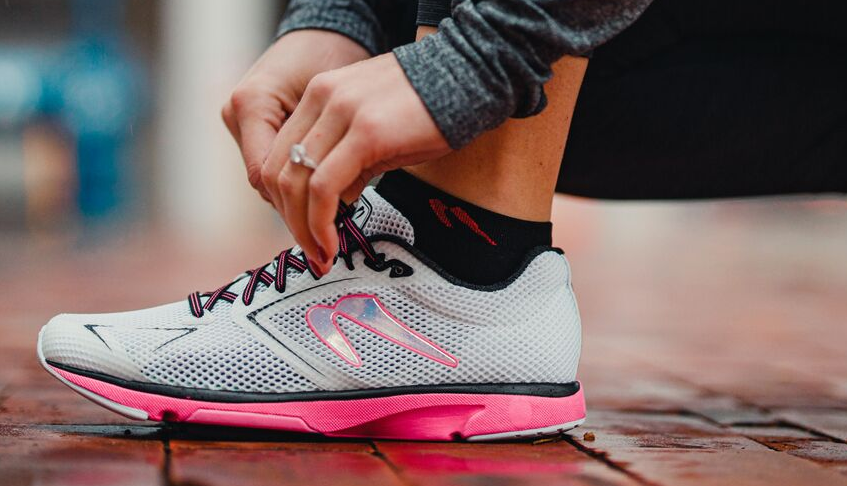
Running 101: Avoiding Common Injuries
natural running overcoming injury running form shoe design9 April 2020
Efficient form and quality shoes are two keys to staying healthy.
Do you think a running shoe with a thickly cushioned heel pad and rigid medial post can keep you from suffering common running injuries such as plantar fasciitis, iliotibial band syndrome or shin splits? Think again.
Recent research and news reports are confirming what those close to the sport have known for years: running shoes with thick midsoles, extensive anti-pronation devices and large heel crash pads don’t prevent injuries.
The key to preventing running injuries is to run with high-quality running shoes and efficient, low-impact running form. Running in heavy, overbuilt running shoes can put more strain on a runner’s body, reduce proprioception necessary to engage proper form and make a runner’s feet and lower legs overwork braking and propulsive muscles and connective tissue — a combination which can actually make a runner more prone to common overuse injuries.
A recent study at the University of Newcastle in Australia concluded there is no scientific evidence to support claims that running shoes with elevated heel crash pads and elaborate anti-pronation systems prevent injuries in runners. The findings have been published in the March 2009 edition of the British Journal of Sports Medicine.
“Since the 1980s, distance running shoes with thick, heavily cushioned heels and features to control how much the heel rolls in, have been consistently recommended to runners who want to avoid injury,” Dr. Craig Richards, one of the researchers, said in a press release announcing the results of the study. “We did not identify a single study that has attempted to measure the effect of this shoe type on either injury rates or performance. This means there is no scientific evidence that [those shoes] provide any benefit to distance runners.”
Dutch researchers have previously found that between 37 and 56 percent of recreational runners become injured at least once each year. The most common maladies are found in the feet and lower legs, but others include pelvis and lower back injuries.
“Not only can we no longer recommend a shoe [with an elevated heel and pronation control system], but the lack of research in this area means that we cannot currently make any evidence-based shoe recommendations to runners,” Richards said in the release. “To resolve this uncertainty, running shoes need to be tested like any other medical treatment, in carefully controlled clinical trials.
“This will ensure that only running shoes with proven benefits can be marketed and sold as therapeutic devices. Until this occurs, health professionals will not know whether the distance running shoes they are recommending are beneficial, harmless or harmful.”
A story in the London Daily Mail confirmed what the Australian report suggested in an excerpt from a popular book called “Born to Run” by journalist Christopher McDougal. That story referenced Dr. Daniel Lieberman, professor of biological anthropology at Harvard University, who offered the startling conclusion that: “A lot of foot and knee injuries currently plaguing us are caused by people running with shoes that actually make our feet weak, cause us to overpronate (ankle rotation) and give us knee problems.”
To run efficiently, you have to understand your body and how it naturally moves across a surface with as little muscular force as possible. The tenants of good running form include running with short strides and a quick cadence, landing lightly on the midfoot/forefoot area (the ball of the foot, but not the toes), and quickly lifting your foot off the ground instead of pushing off with excessive muscle force. A slight forward lean and a relaxed arm swing are also key components.
To illustrate what Newton Running calls the “Land-Lever-Lift” technique, take the simple test of running barefoot across a smooth floor. More than likely, you’re naturally going to land lightly at your midfoot/forefoot and quickly pick up your foot to start a new stride. Your body doesn’t allow you to land on your heels because it isn’t engineered to accommodate the blunt force trauma of repeated heel striking. Unfortunately, most contemporary running shoes have been designed for running form that demands heavy heel striking and dampens the afferent feedback which allows the foot to sense the ground.
Two of the biggest mistakes distance runners can fall prey to are 1) excessive heel striking that causes abrupt braking of forward momentum, and then pushing off too hard with the toes to start the forward motion again; or 2) using only propulsive muscles,(the calf group, hamstrings and Achilles tendon) by running too far up on their toes like a sprinter and not using the body’s natural cushioning system. Each of those form flaws puts too much vertical movement into every stride, and that leads to inefficiency and considerably more impact, muscle and tendon stress on the body.




